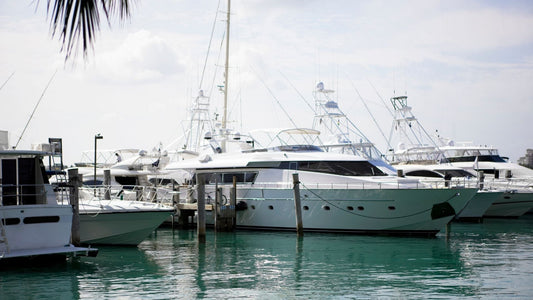
Can I Use a Brush on Boat Seats?
Nicholas HeislerShare
Buying a boat is a significant investment. Maintenance, accessories, and fuel drive up costs even higher. But the costliest expense of all is failing to maintain the boat properly, including the simple act of cleaning. Regular boat cleaning is essential, but only with the correct tools and processes. Yes, brushes are one of those tools, even for seat upholstery, as long as owners use brushes designed for that purpose.
Why Is Cleaning Seats Important?
While the hull may get the lion’s share of attention thanks to the threat of spreading invasive species, a boat’s interior is just as important. Faded vinyl covered in mold isn’t just unsightly — it can stain clothing and towels, cause health problems, and drive down the value of a boat. While modern boat vinyl does have anti-mold and mildew properties, these properties degrade when not cleaned properly.
The Best Types of Brushes for Seats
Boat seat upholstery has different requirements from the rest of the boat. Here are the properties you want when selecting your brush:
Soft Stiffness
While the hull will require stiff-bristled brushes, these brushes will damage seat upholstery. For seats, owners should stick with soft-bristle brushes. They won’t cause deep scratches or tears in vinyl but will require longer scrubbing sessions to remove dirt.
High-Quality, Dense Bristles
Generally, the bristles are plastic, often a form of polystyrene, nylon, or rubber-infused material. You’ll want a material that is soft yet able to withstand lots of scrubbing without degrading.
Wooden Head
Brush heads are usually wood or plastic, but wood is more durable.
Telescoping, Rust-Resistant Metal Handle
You’ll need a telescoping handle so you can change the length based on your needs. Also, it should be made of a hardy, rust-resistant metal such as aluminum or stainless steel.
Cleaners
A quality wash and wax soap will simultaneously remove dirt, debris, and other contaminants from seats while also adding a protective wax layer. However, boat owners must take care to use soaps and cleaners that are safe for use on vinyl. Also, ensure that the cleaner you use features UV protection. Your boat seats will sit in sunlight for much of the year, and UV damage will cause unprotected seats to fade.
Cleaners that use harsh chemicals can not only harm seat upholstery but can damage brushes as well. You also must consider that you and other passengers will have to sit on the recently-cleaned seats, and detergents with toxic materials can stain clothing and even harm the skin. The cleaner you select should ideally be biodegradable and non-toxic to protect occupants, the boat, and the environment.
Boat Seat Cleaning: Best Practices
Here are the steps for maintaining fresh, new-looking seats:
1. Sweep Away Dirt and Debris
With a soft brush, remove loose dirt or debris on the seats.
2. Wipe Down the Seats With Distilled Water
Distilled water will not introduce any contaminants. Use a soft cloth or rag to gently wipe the water on the seats, then use a different cloth or rag to dry them.
3. Mix Your Cleaner
Read the instructions on your cleaning solution and prepare a mixture in a bucket. You may be able to use tap water rather than distilled water, but again, check the instructions.
3. Softly Scrub
Using your soft brush, gently clean the seats. If you have removable cushions, take them off the seats and clean them all over.
4. Wipe, Rinse, Dry
Once you’ve thoroughly cleaned every upholstered surface, get a fresh, soft cloth or rag and wipe the surfaces down. Then, rinse and dry with a new cloth.
Improper Cleaning
Cleaning your seats with the wrong tools or cleaners will result in damage. This is why you should avoid using:
● Power Washers: The pressure can cause vinyl to rip
● Harsh Cleaners: Bleach, Goo Gone, and other harsh chemicals remove protective coatings
When in doubt, read the instructions and obey warnings. If the cleaner label claims it will harm vinyl, don’t use it!
Preventing Damage Long-Term
To ensure your seats last from season to season, clean them every month. You can clean them more often if you notice buildups of grime or mold. Also, you can enact these preventive measures:
● Don’t spill food, drinks, or sunscreen on the seats
● Wipe the seats after all boating sessions
● Use covers when the boat is not in use
● Never cover the seats if the interior is wet, as this can lead to mold growth
With some simple care, your seats can stay pristine.
When it comes to keeping your boat clean, look to Captains Preferred Products boat cleaning supplies. Find everything you need to keep your vessel squeaky clean all season — always at the best prices.




